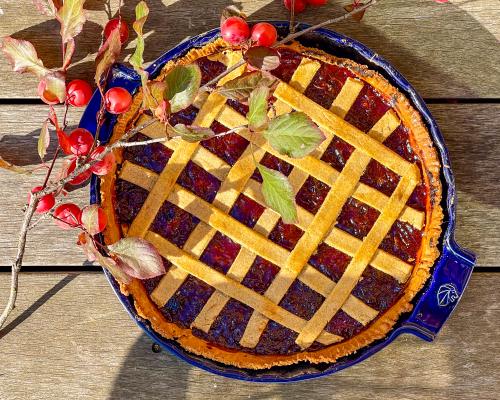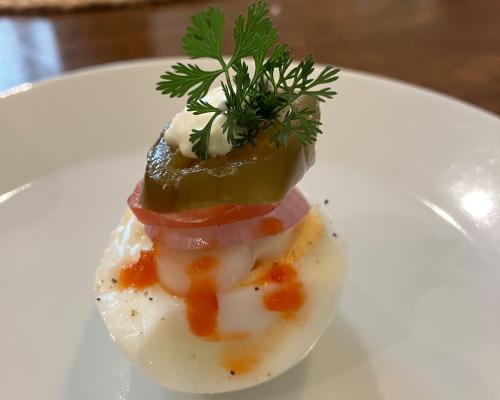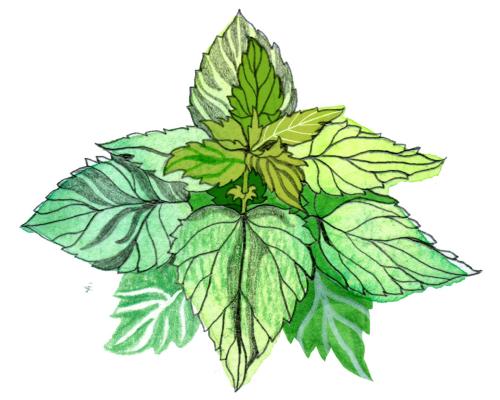
We’ve got a huge, beautiful, red-leafed cherry plum tree in our back garden, and right now it’s raining plums! Have you noticed the sheer abundance of fruit this year? The branches are heavy and the ground is scattered with fallen fruit. Last weekend, I harvested about 10kg plums from our tree, and my daughter suggested we make a jam tart. It turned out to be one of the best I’ve ever eaten, sweet yet sharp, sticky and rich. A simple, seasonal treat.
Raining plum jam tart
From plum to pear, every fruit tree I pass this year seems to be laden with fruit. This kind of bumper crop is known as a mast year. Some fruit trees swing naturally between light and heavy harvests from year to year, depending on whether they’re focusing energy on growth or fruiting, and it’s thought that this cycle may be an evolutionary tactic to support seed dispersal. By producing a glut, more fruit is eaten and spread by animals. This recipe is a great way to turn that glut – whether that’s a discounted punnet of berries, windfall apples or a bag of scrumped plums – into something to savour. Jams are one of the simplest and most delicious ways to preserve the season. If you’re making your own pastry, don’t forget to save any scraps to weave a lattice topping or shape into biscuits. I like to season mine with a little olive oil and whole spices before baking.
For the jam
500g plums
250g unrefined sugar
½ unwaxed lemon, ideally organic, cut into four wedges
1 large blind baked tart case, homemade (see below and method) or bought in
150g shortcrust pastry, for the lattice topping (optional)
For the pastry (optional)
300g wholemeal flour (eg, khorasan, emmer or spelt), plus extra for dusting
150g cold butter, diced
A pinch of salt
3 medium eggs
Wash and stone the plums, then put them in a thick-based saucepan with the sugar and lemon wedges. Bring the pan to a boil on a medium heat, then turn down to a simmer (take care the mix doesn’t boil over). After 20-30 minutes, once the jam has started to reduce and turn thick and sugary, take it off the heat (if you have a thermometer, boil the plum mix to 101C, to make a loose jam).
To make your own wholemeal pastry case, in a food processor blend the flour, cold diced butter and a pinch of salt for 30 seconds, until the butter is finely mixed into the flour. Add two of the eggs and two tablespoons of cold water, then pulse for about 30 seconds, until the pastry comes together into a ball; add a touch more water, if need be.
Turn out the dough on to a lightly floured surface and knead very briefly, until evenly mixed. Shape into a thick round disc, place on a plate, cover with an upturned bowl and chill in the fridge for 30 minutes. Meanwhile, heat the oven to 200C (180C fan)/390F/gas 6.
Roll out the pastry on a floured surface to the thickness of a £1 coin, turning the dough as you go and dusting with more flour if it threatens to stick. Once the pastry round is large enough to line the base and sides of your tart case, roll it on to the pin and unroll it directly into the case. Gently ease the pastry it into the corners, then wrap the overhanging pastry up and over the rim, pressing it against the outer edge with a fork. Don’t worry if it cracks or any holes appear: that’s a sign of a nice “short” pastry – simply fill any gaps with leftover pastry or seal any cracks by pressing it back together. Next, using a serrated knife, trim the excess from the top and gather the offcuts into a ball. Chill and save for the lattice.
Prick the base with a fork to stop it puffing up, then bake for about 18 minutes, until just cooked and lightly browned. Meanwhile, make an egg wash by beating the remaining egg with 30ml water. Take the baked case out of the oven, brush with the egg wash (this will fill any fork holes) and return to the oven for another five minutes. Remove and leave to cool before filling (though if you want an extra glazed tart, repeat the glazing and baking for five minutes process once more).
Fill your homemade or bought in pastry case with a 1cm layer of the plum jam. If you’ve made your own pastry, roll out 150g excess pastry into a rectangle the length of the inside of the case, cut into 1-1½cm-wide strips, then arrange in a lattice on top of the jam.
Bake in a preheated 200C (180C fan)/390F/gas 6 oven for 15 minutes, then remove and brush the lattice with an egg wash made from a little milk or a beaten egg thinned with a splash of water. Bake for a final five minutes, until golden, then remove, leave to cool and enjoy with creme fraiche, yoghurt or vanilla ice cream.







